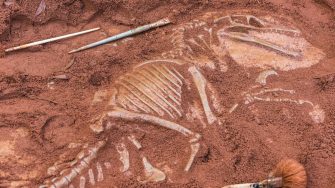
Synopsis
The primary goal is to identify the position, and ideally depth, of the next subsurface inside bend of the Wipajiri Formation channel deposit to the east of the eastern edge of Lake Ngapakaldi. To do this, we’ll use Synthetic Aperture Radar satellite imagery so that the palaeontological team can continue to make fascinating new discoveries about other creatures that once lived in central Australia.
This is an exploratory study in that we’re trying to establish to what extent it may be possible to use satellite imagery to determine the probable location of more of the deposit.
To this end, we are using a combination of local knowledge, prior evidence and advanced image processing of remotely sensed data to identify landscape clues, such as paleochannels, change in vegetation, dune heights and geoforms.
Prior research in desertic and semi-desertic areas has resulted in successful detection of buried fossil deposits.
Success in detection is dependent on the following:
- landscape factors, like soil type, soil moisture or vegetation cover
- depth of the buried deposit
- type of image used, for example, wavelength and optical or microwave measurement.
Aims
The primary goal is to identify the position and depth of the next subsurface inside bend of the Wipajiri Formation channel deposit to the east of the eastern edge of Lake Ngapakaldi, using Synthetic Aperture Radar satellite imagery.
Supervisors: Prof. Mike Archer, Prof. Sue Hand, Prof. Shawn Laffan and Prof. Graciela Metternicht.
Get involved
To learn more about this project, contact Professor Graciela Metternicht.
E: g.metternicht@unsw.edu.au
T: +61 2 9385 5761
